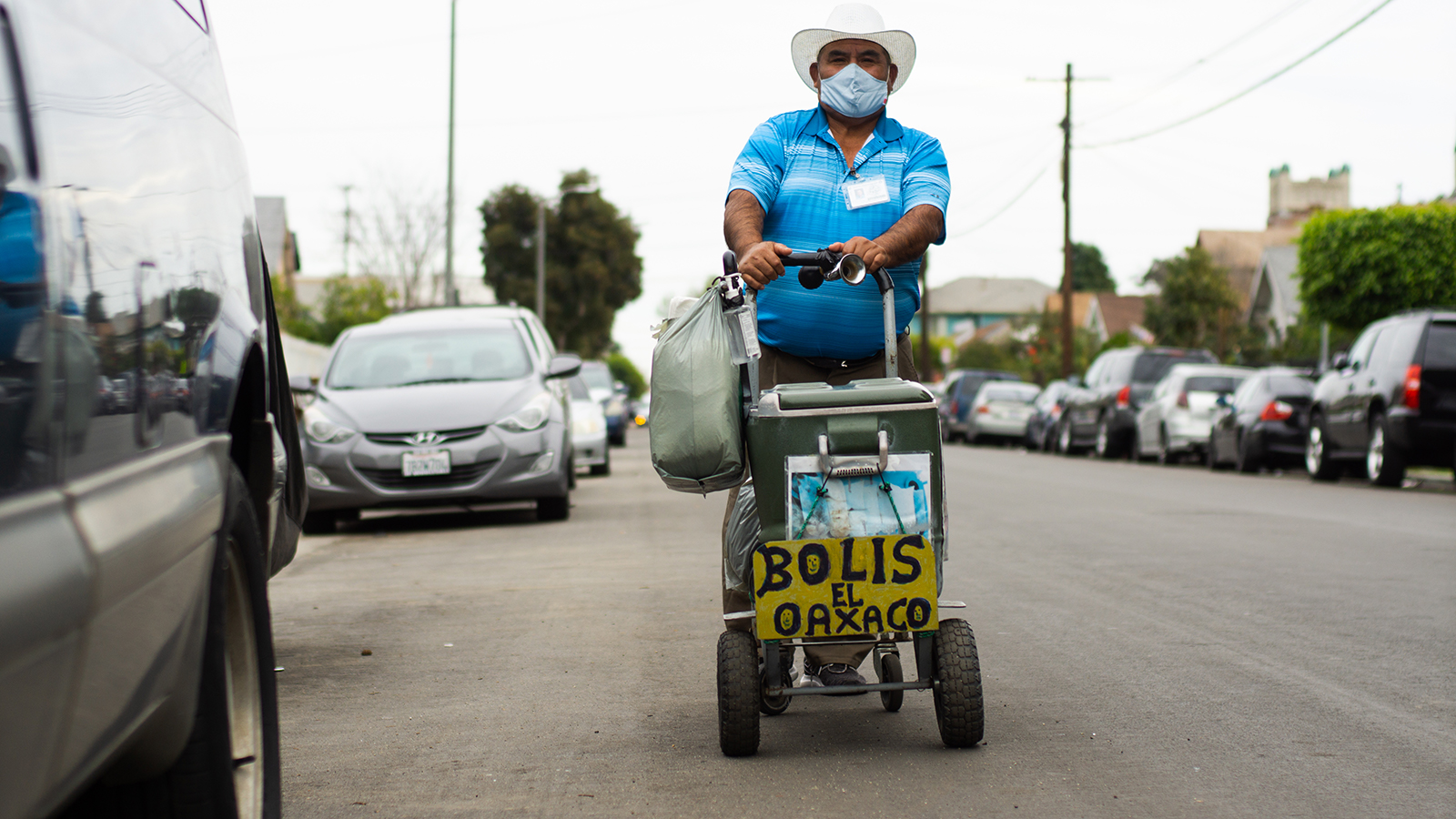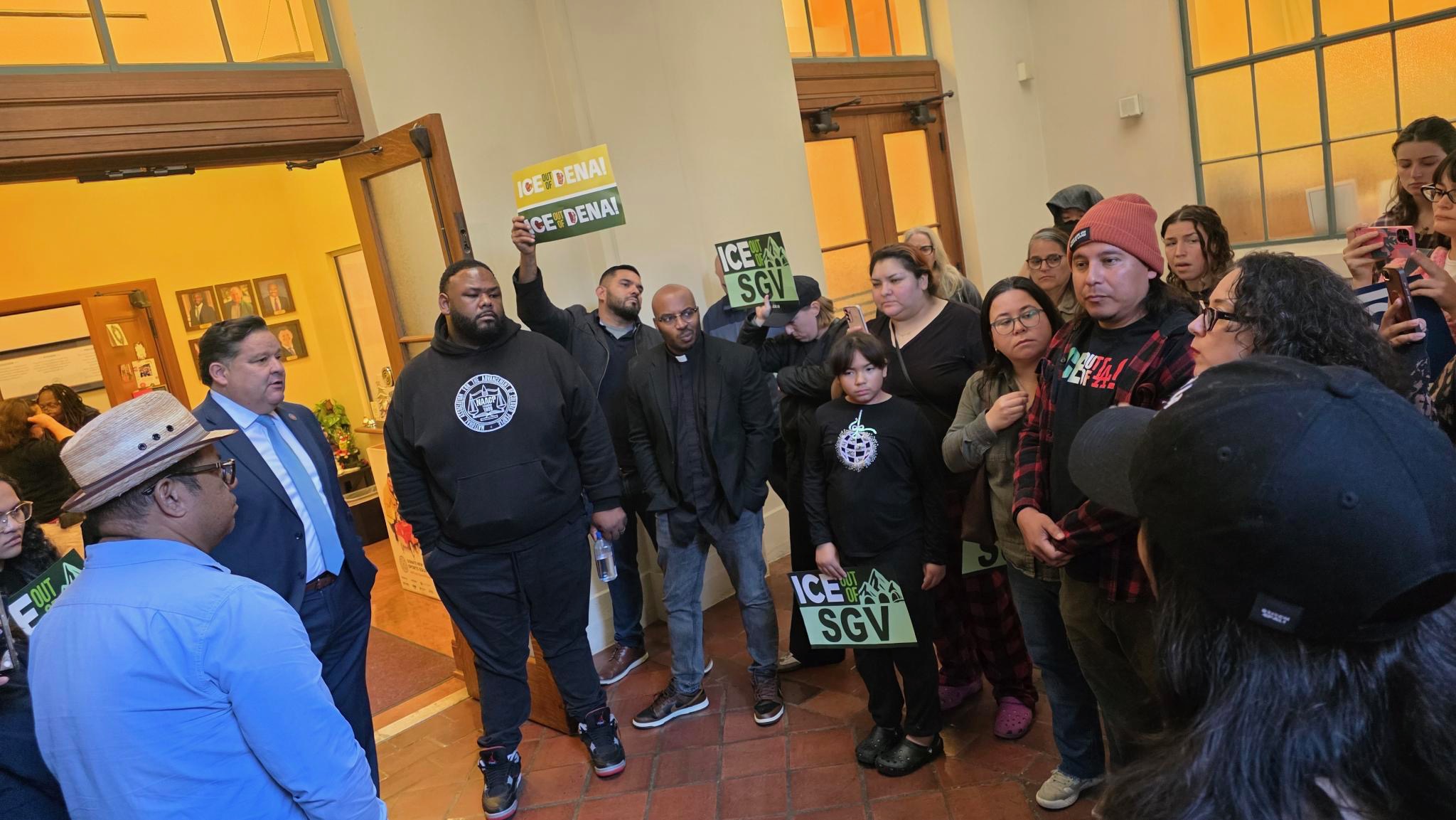In 2016, Juana Dominguez was serving her locally famous quesadillas from her stand south of downtown Los Angeles at Main and 41st streets when two 24-foot flatbed trucks pulled up, each half-filled with the confiscated carts of other street vendors.
The day Dominguez dreaded most had arrived and there was nothing she could do about it. The Los Angeles County Department of Public Health (DPH) had come for her grill. (Editor's Note: An earlier version of this story mistakenly referred to the DPH as a city agency.)
This article was co-produced and co-published with Capital & Main, an award-winning publication that reports from California on economic, political, and social issues.
Dominguez, 52, and her husband had splurged on the grill for $3,800 at a yard sale. It did everything Dominguez needed, combining a broad flat-top comal with a full refrigeration system to keep salsas and other toppings cool—but it still didn’t meet Los Angeles County’s stringent health code. Soon it joined the other seized grills and carts. Dominguez watched the flatbed truck round a corner on Main Street and vanish.
Annual city permits are priced at $291 ($541 after July 1), while county permits cost $772 yearly. Vendors must also pay $746 for a one-time cart inspection. Licensing permits for California physicians cost $820 every two years, by contrast, in a profession with median salaries of more than $200,000.
Nearly five years later in Los Angeles, the lack of an affordable, code-compliant vending cart is threatening to derail the city’s historic effort to legalize the sale of street food. Even if vendors can afford the expensive permits they need to sell legally, they still cannot get their carts approved by the Department of Public Health (DPH) because the county’s health code was written for brick-and-mortar restaurants. For prepared-food vendors to receive permits, their carts must include a handwashing sink, a three-compartment sink for kitchen wares, and substantial refrigeration and storage space. Permits also cost staggering amounts for a street vendor making $10,000 a year: Annual city permits are priced at $291 ($541 after July 1), while county permits cost $772 yearly. Vendors must also pay $746 for a one-time cart inspection. Licensing permits for California physicians cost $820 every two years, by contrast, in a profession with median salaries of more than $200,000.
After 15 months since the official launch of the Sidewalk and Park Vending Program, only around 1% of street vendors selling food in L.A. County are permitted. If Los Angeles wants to solve its street vending issues, it must either develop a cart capable of meeting its health code or make the health code more lenient toward carts, say vendors and vendor advocates. Meanwhile, enforcement of vendors like Juana Dominguez continues, even though strict regulations mean vendors cannot acquire permits even if they can afford them—or even if they can navigate a permitting maze so punishing it would make Kafka blush.
According to Paul Gomez, an official with the city’s Department of Public Works, Los Angeles has issued 546 vending citations since March, and more than 2,000 no-penalty violation notices, which direct vendors to the application process. Los Angeles County also conducts its own enforcement via the Department of Public Health, which frequently descends into violent clashes with sheriff’s deputies or other law enforcement agencies.
In September of 2020, DPH officials and Los Angeles County Sheriff’s Department (LASD) deputies surprised vendor Max Hipolito, throwing out all his food and salsas and confiscating his equipment, even though no misdemeanor was officially issued. In February of 2021, a brawl erupted when DPH officials and El Monte police officers inspected an Indigenous taco seller. Officers tackled and threw vendors to the pavement as onlookers screamed and filmed with their phones. In a statement to L.A. Taco, El Monte PD confirmed they were “assisting Los Angeles County Health Inspectors with a safety inspection of perishable items sold by street vendors.”
“When [the DPH] inspect restaurants, I have not heard about instances where they’re calling law enforcement to enforce the rules,” she said. “I find this pretty troubling.” - Nithya Raman, L.A. City Councilmember
“The police department has assisted the health inspectors with these types of health and safety inspections in the past,” the statement continued. “The police department plays a supportive role in this process, and these inspections are necessitated by public concerns and complaints dealing with public health.”
Spokespeople for LASD, as well as watch commanders at stations in Compton, Inglewood and East Los Angeles, could not confirm that deputies assist the DPH with vending inspections. When asked about collaboration with sheriff’s deputies, the DPH declined to comment, as did Los Angeles County Supervisor Hilda Solis. City Councilmember Nithya Raman was critical of the practice. “When [the DPH] inspect restaurants, I have not heard about instances where they’re calling law enforcement to enforce the rules,” she said. “I find this pretty troubling.”
In September of 2020, the L.A. County Board of Supervisors approved a program to develop a code-compliant, affordable cart, and in December hired vending advocacy nonprofit Inclusive Action for the City to oversee the project. The Kounkuey Design Initiative (KDI) is developing the cart itself.
“We’re trying to solve cooked meat,” says KDI’s Naria Kiani, who is overseeing the cart team. Cooked meat is subject to the most stringent health code rules. The 124 vendors permitted so far are likely to sell prepackaged food, like ice cream or snacks, since meeting complex food preparation requirements is so difficult.
Other American cities, including New York, do not impose Los Angeles' stringent rules on street food vendors.
As a first step, Kiani’s team drafted a cart design following the current health code to the letter, figuring they could whittle down the design from there. But the end result weighed 700 pounds.
“Water is really heavy,” she says. “[The cart] needs potable water for washing hands and things like that. It needs four sinks and 20 cubic feet of refrigeration space.”
Other American cities do not impose Los Angeles’ stringent rules on vendors. In New York, vendors cooking meat or conducting other complex food preparation only need single-compartment sinks. “The County of Los Angeles Department of Public Health is responsible for enforcing the California Retail Food Code, which is State law,” the DPH wrote when reached for comment. “Any changes to the long-standing health and sanitation requirements of the California Retail Food Code would require legislative action.”
Inclusive Action is also hoping to change the health code itself, in case the code’s requirements can’t be met, and are working with the DPH to see where concessions can be made. They aim to release a cart blueprint by the end of June, according to policy director Lyric Kelkar, with a price tag under $7,000.
* * *
As Los Angeles County works to develop a uniform cart for its estimated 10,000 street food vendors, the reality is that carts come in all shapes and sizes based on the vendor’s product, their budget and other factors. Los Angeles’ iconic microentrepreneurs use a range of DIY setups.
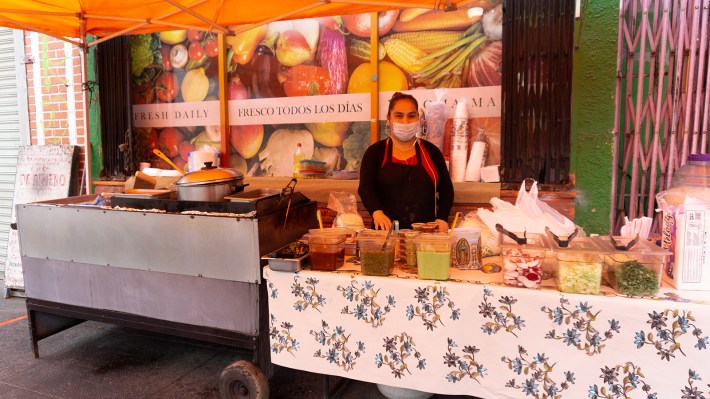
For example, hot dog vendors, taco vendors and even fruit vendors have stands that are immobile, standing in one designated area every time they go out to sell. Stands range in size and usually come with flat tops heated by propane. On the other hand, street vendors who sell items like ice cream, raspados (shaved ice) and corn use what they call push, or mobile, carts. Push carts can be made out of shopping carts or a mixture of dollies and coolers.
In the last 10 years, Juana Dominguez has had her equipment taken away three times. But she says her greatest loss had to be her first legitimate cart, which took several years of her selling gum, candy and other food in the streets before she made enough money to invest in a quality cart.
Until Los Angeles’ street vending economy is legalized, vendors are stuck between violent robbers and the hostile law enforcement that is supposed to protect them from attacks in the first place.
“We didn’t even finish paying it off before it was taken away,” says Dominguez. “It was almost like hitting rock bottom for us.”
Her new setup, a simpler and smaller model, cost her $800. The steel grill that she purchased secondhand has a built-in comal and enough room for one pot and metal containers that keep her meats warm. Because this cart did not come with a refrigerator, she now keeps her salsas and toppings on a table next to the grill. Bright social-distancing tape surrounds the grill and table to follow COVID-19 restrictions and protect Dominguez from disastrous fines. The Mexico City native says affordability, size, and guaranteed permits top her list of concerns.

In the Piñata District in downtown Los Angeles, Mario Ramos sells nieve de garrafa, an ice cream made with a mixture of fresh fruit, sugar and water, traditionally prepared in a steel tub that sits over ice and salt.
His vendor voice needs no loudspeaker; with a deep but friendly tone, it invites everyone who passes by to try his ice cream. “¡Tenemos fresa, mango, coco!” (“We have strawberry, mango, coconut!”) Ramos learned his baritone from his father and grandfather, both of whom were vendors, he says.
Vendors who spoke with L.A. TACO and Capital & Main said they would willingly pay up to $5,000 for a permitted cart.
He has 24 flavors on display. Each ice cream is prepared in the mornings at his home. Every weekend he unfurls banners around a cart he created himself: three red dollies supporting 12 coolers from Walmart. Packing the coolers with dry ice converts them into miniature fridges.
The entire setup cost him a little over $200.
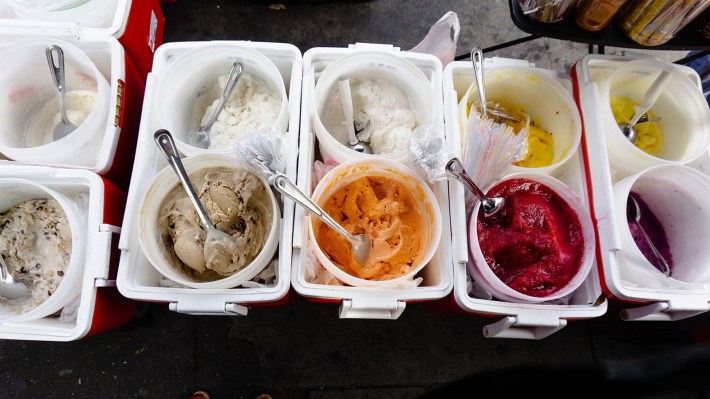
In the last 16 years of street vending, Ramos has gone through 40 of these “disposable carts,” as he calls them. Some were seized by the county and others wore out over time.
“What I think other vendors would like is for the city and whoever designs the carts to be in communication with us,” says Ramos. “Only we know what we need.”

Ramos and other vendors have also attempted to design carts themselves. Once Ramos created a mobile stand made out of a golf cart for vendors who sell raspados. “This can eliminate having to push the heavy cart around,” he says.
KDI also distributed a survey to vendors asking what they wanted from a cart, according to Naria Kiani. The main requests? Something affordable, code-compliant, and light enough to get over the curb.
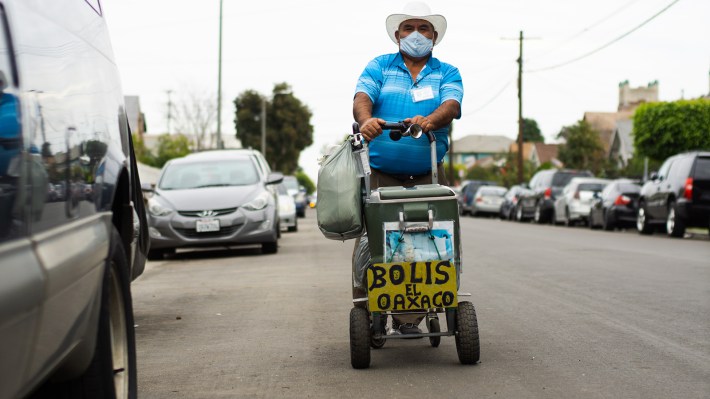
Older vendors, like 66-year-old Faustino Martinez, currently facing financial hardship due to the pandemic, say affordability has to be top priority in the city’s plan to design “the perfect cart.”
To build his cart, Martinez added wheels to a dolly in hand-truck mode, lashed a cooler to the bars and completed the system with a horn, hand sanitizer zip-tied to the cooler, a bag of napkins and a sign painted on the underside of the dolly’s original platform. “That’s all I need,” says Martinez. He stores his Oaxacan-style bolis — water-based ice creams sealed in small plastic bags — inside his cooler. The cart is easy to push and inexpensive, he says, but still an upgrade over the shopping cart he used before. Vendors who spoke with L.A. TACO and Capital & Main said they would willingly pay up to $5,000 for a permitted cart.
“We are in deep with the pandemic,” says Ramos. “There’s no savings, so the only way I see it working would be with payments.”

* * *
In a small trailer office at Vahe Enterprises, a food truck manufacturer on Slauson Avenue, engineer Richard Gomez clicks through cart designs on a PC—each one rejected by the L.A. County Department of Public Health.
Gomez grew up vending in South L.A. and began working on carts in 2017 when Benjamin Ramirez, a corn seller, or elotero, was attacked in Hollywood. Gomez was convinced his latest, most conservative design — a simple tamale cart not intended for any food preparation — was sure to pass inspection. But the DPH rejected it, asking Gomez to include a microwave.
Outside his office, the engineer climbs into a golf cart and whips it through two enormous food truck “commissaries:” parking lots with grease interceptors and pull-down hoses where trucks can safely dismantle and clean their equipment. Commissaries also include kitchens where food truck chefs prepare and cook food for the day. This commissary is the largest in California, he says, home base for nearly 800 trucks, including LudoTruck, King Taco, and Trap Kitchen, and is one of more than 25 in L.A. County. The commissaries are critical infrastructure for L.A.’s food truck industry; no food trucks could operate without them.
Any serious, large-scale effort to legalize street vending will also require cart commissaries, which are already mandated by the health code. Street vendor Ngoc Nguyen, who was the first street vendor to sell pho in Los Angeles out of Highland Park, cites the commissary requirements as one of the main obstacles between him and his permits. “You cannot cook out of your house,” he says. “To be completely legit you’re also going to need to set up an agreement with a commissary or work out of a licensed kitchen.”
In 2018, Gomez convinced Vahe Enterprises to invest $1.5 million into a cart commissary, but the site, which sits beyond the bustling food truck sections, is still unused. Gomez looks around the empty space and sighs, toeing a grease drain with a leather Converse shoe. “This passed inspection and was approved, but the carts weren’t,” he says.
Though hesitant to disclose their location to the police, vendors are frequently the targets of crime and want panic buttons included in the County’s cart design, but only if the carts are permitted—calling police to unpermitted carts might only cause further trouble.
Meanwhile, vendors like Juana Dominguez also want the city to consider their safety when designing a cart. In late December of 2020, while Dominguez was at home recovering from COVID-19, Dominguez’s employee was attacked. A man came with a knife and followed the employee around the toppings table before splashing her face with an acid, according to Dominguez’s husband, who witnessed the attack.
“When I returned to work I cried with her,” says Dominguez. “It would be great to have some type of protection for us because we run so many risks when we sell.”
Though hesitant to disclose their location to the police, vendors are frequently the targets of crime and want panic buttons included in the County's cart design, but only if the carts are permitted—calling police to unpermitted carts might only cause further trouble. Currently, KDI is not including panic buttons or a GPS system in their design, though they’re aware of vendors’ concerns.
Dominguez imagines buying a code-compliant cart equipped with a panic button. “It would be like buying safety,” she says.
Mario Ramos has been robbed multiple times. In one encounter, thieves split his head open and left him on the sidewalk. And despite unpleasant encounters with the city and law enforcement, he still wants a GPS and a panic button on his cart.
“You get home bleeding without money,” says Ramos. “You’re left speechless. Having a panic button would be great.”
Until Los Angeles’ street vending economy is legalized, vendors are stuck between violent robbers and the hostile law enforcement that is supposed to protect them from attacks in the first place.
“Believe me,” Ramos adds, “Our jobs are not envied by any American. We’re proud to be on corners and sidewalks. We’re just asking for a fair shot.”
